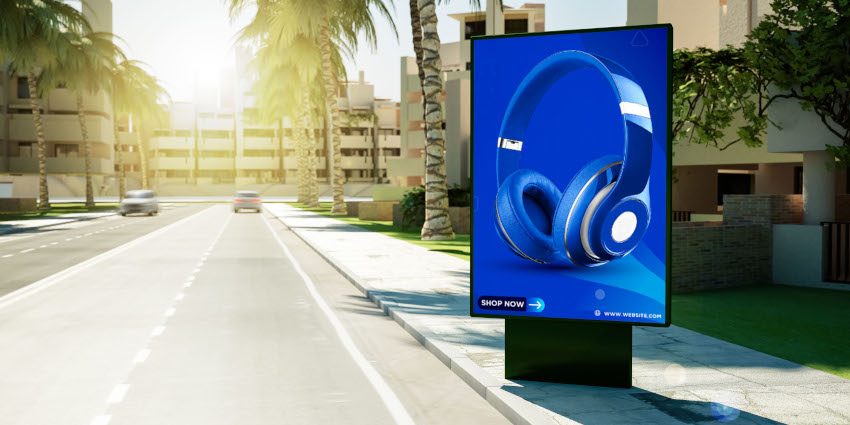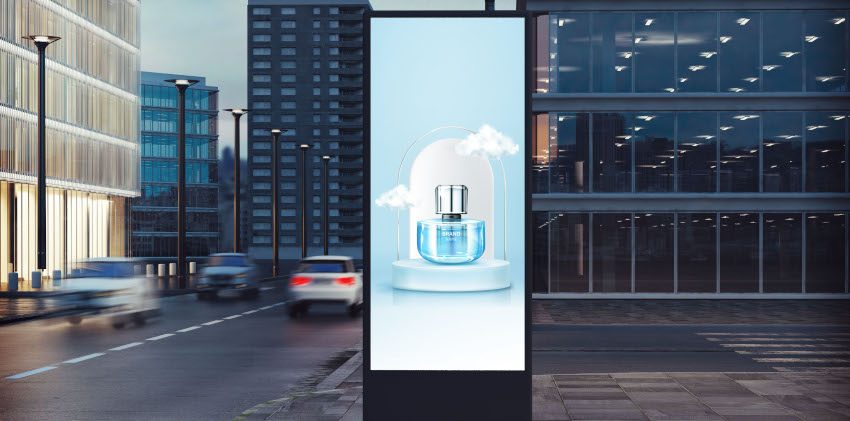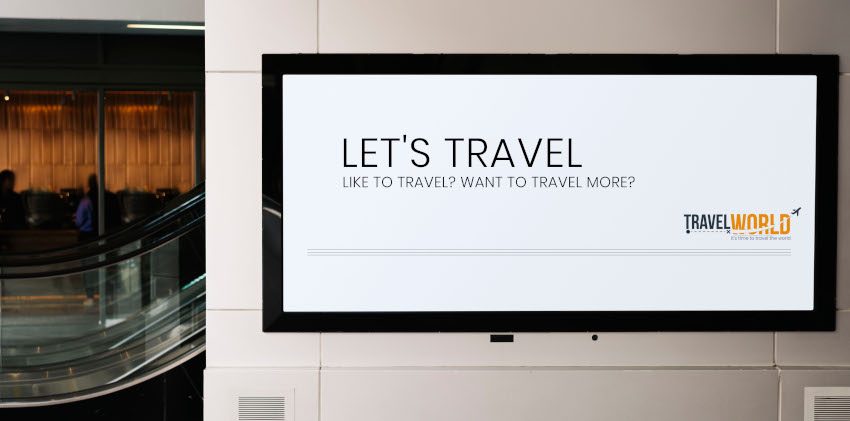Why Should You Choose Digital Signage Over Other Advertisements?
Digital signage advertisement has significantly grown from strength to strength. It has become a familiar sight everywhere you look around you. From commuter stations to storefront windows and POS points in supermarkets, digital advertising has transformed how companies reach out to their customers. The adoption of digital signage solutions is on a steady rise, with 60% of enterprises without digital signage in their stores planning to invest in the technology within the next two years.

More interestingly, digital signage helps transform everyday locations into unexpectedly engaging customer touchpoints. Enterprises that effectively implement digital signage advertisement can deliver hyper-targeted, data-driven marketing campaigns to help them reach a broader audience. So, they can get more bang for their buck, meaning a better return on investment.
Accordingly, businesses in various industries have adopted digital signage to minimize overhead costs, improve customer experience, and successfully market their brands. Here are a few reasons you should opt for digital signage over traditional advertising. However, before then, let’s delve into the basics of digital signage advertising.
What is Digital Signage Advertisement?
Digital signage is also known as digital signs, signage solutions, electronic signage, DOOH, and LED billboards. Essentially, it comprises a media player, a screen, a content management system (CMS), and the content you display on-screen. Advertisers can use digital signage systems in both indoor and outdoor locations.
Indoor digital signage advertisement is place-based, while outdoor digital signage is large format media. It’s the digital signage display commonly used at bus stops, on the sides of buildings, and in city squares. In its outdoor and indoor forms, digital signage advertising provides the best marketing strategy to capture your audience’s attention.
Unlike other ad formats you can switch off or avoid, digital signage offers unmissable, real-time multimedia campaigns. With digital signage ads, you can deliver content that features everything from imagery and high resolution to animation to RSS feeds and URLs.
Top Benefits of Digital Signage Advertisement Over Traditional Ad Formats
Traditional advertising no longer has the attention-grabbing appeal it once had because of its many distractions. Consumers are now tech-savvy and likely to notice high-resolution digital displays rather than old-fashioned and dull static signboards.
Moreover, electronic signage provides more vibrant movement and colors than other forms of advertising. These factors alone attract a large audience, making digital signage advertising ideal for highly targeted marketing. That explains why forecasts have it that the digital signage industry will grow to about $28 billion by 2026, up from $16 billion in 2021. How is digital signage advertising superior to traditional ad formats? Let’s delve into the details.
1. Creates Multi-Sensory Experiences
People spend a lot of time staring at screens because they are eye-catching. With digital signage, you can stream visually appealing content across high-definition screens, touch screens, and android devices. Indeed, consumers walking past digital screens are more likely to absorb the content than they would when passing a conventional poster or sign.

Additionally, digital signage platforms increase consumers’ memory and information retention rates. That translates to improved recall of your business and brand recognition. Therefore, think of how to create digital signage that makes consumers remember you when they need a particular product or service.
2. Reduces Overhead Costs
The upfront costs for implementing digital signage solutions include hardware and software costs. However, one difference between digital signage and conventional advertising methods is that the former doesn’t incur expenses for producing marketing materials.
Besides pricing marketing materials, traditional marketing involves spending time creating, printing, and setting up advertisements. On the contrary, digital signage advertising only requires you to develop and display content through several digital signage media.
The most significant disadvantage of static signage is that it’s impossible to change it without returning to the drawing board and re-printing. That translates to more money. On the other hand, digital dashboards are fast and easy to update on the signage based on your business needs. Simply open your digital signage content management system and make changes on the fly. Online tutorials can guide you on what to do if you are unsure how to use digital signage software.
3. Allows Your Audience to Choose Content
One case study by Eclipse Digital Media established that 29.5% of customers purchase products because of digital menus. When your potential customers have the liberty to choose and customize content in real-time on digital screens, it boosts their engagement with your business.
Interactive kiosks are capable of storing a lot of content. The user-friendly kiosks provide information on anything from botanical gardens to museums and restaurants. Moreover, digital signage kiosks offer wayfinding information. For example, consumers can take virtual 360-degree tours through digital signage.
4. Enables Customers to Make Better Purchasing Decisions
Many customers, especially Millennials, prefer making their own purchase decisions. When a sales assistant approaches, in-store shoppers are likelier to turn down a purchase idea. That’s a traditional marketing approach. Many companies have adopted interactive screens to find better ways to persuade customers. Statistics show a digital sign’s curiosity and intrigue can draw 76% of customers to a business.
Digital signs can tilt a shopper’s opinion in favor of your products. Some clever ways of utilizing interactive digital signage include demo videos of products you want to sell. Additionally, you can try adding a ‘People’s Choice label on higher-value products in a digital product catalog. Likewise, in-store retail digital signage can provide recommendations to your customers based on their gender, demography, and purchase history.
5. Lower Perceived Wait Times
No one enjoys waiting in line, and many shoppers leave a store because of long queues. That is the reason why many businesses invest in many point-of-sale systems. Some offer self-checkout to prevent lengthy lines from discouraging customers from purchasing.

Occupied time feels shorter than unoccupied time. In other words, when distracted from the wait, people have an easier time waiting in line or in waiting rooms. For this reason, many restaurants hand out menus to customers waiting for their meals. You can replace this traditional trend with digital menu boards. That can help you distract customers from the wait and make them eager to order much sooner.
In retail stores, entrepreneurs can use video walls and digital screen templates near till points. The displays attract and engage customers with images and videos related to their products. Additionally, you can use these digital displays to show weather forecasts, live news, RSS feeds, and sporting events.
6. Digital Signage Offers Analytics
Conventional advertising doesn’t come with effective analytics. Therefore, it’s difficult to determine the most preferred products and services. On the other hand, digital signage systems come with analytics software. You can generate a report on the most searched-for products and services. If sales are inconsistent, you can lower the price or create incentives to improve the customer’s perceived value.
Furthermore, some digital signage displays have video cameras that capture the eye movement of shoppers. This helps reveal the areas that attract the most attention. A digital signage player can also capture dwell time to help determine the stores or aisles with the most traffic. Additionally, these analytics can help you improve the display. For example, if you find shoppers aren’t completing the video you play on loop, you can create more compelling content.
7. Allows Real-Time Digital Content and Updates
Traditional ad formats are the curse of any business or brand because their credibility and appeal are decimated. Moreover, their overall image no longer attracts the modern tech-savvy consumer.
Conversely, most modern screen management solutions provide digital content apps that gather live information from third-party systems. Their design is such that they can then project the content on a digital signage display.
All live content can benefit from these apps, including RSS News feeds, weather updates and social media feeds. You and your authorized team of users can edit live content and schedule marketing campaigns on playlists to run on a loop or at specific times. Whether you want to display full-screen or multi-zone content, digital signage allows you to achieve that.
As digital signage technology evolves, real-time content will become one of the most popular types to display on digital signs. Overall, access to real-time content and updates go a long way in enhancing the customer experience. With digital signage, your business can effectively stay up to speed and keep up with the latest trends.
Digital Signage Advertisement: The Proof is in Your ROI

Digital signage advertising is the next big thing after social media marketing. This technology integrates information into displays through RSS feeds, apps, and widgets. Digital signage applies to mobile devices, web pages, and multimedia. When investing in digital signage, ensure clear-cut layouts and informative and entertaining content to promote increased playback.
If you are on a tight budget, don’t fret; many websites provide free digital signage. You can effectively stand out from your competition by implementing digital signage in your marketing campaigns. Ultimately, you’ll experience an improvement in your client base and customer satisfaction rates.


